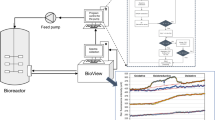Abstract
Dextrose has been fermented in a Tokyo Rikakikai fermentor at five different temperatures ranging from 28 to 31 °C with Saccharomyces cerevisiae (Baker's yeast) as seeding. The progress of the reaction was recorded by measuring the fluorescence signal due to intracellular reduced nicotinamide adenine di nucleotide (NADH) present in the cells with a Dr. Ingold (Switzerland) fluorosensor which has an excitation wavelength of 360 nm and measurement wavelength of 450 nm. The optimum temperature which gave maximum growth rate and maximum biomass concentration in minimum time was found to be 28 °C. The fluorescent voltage data fitted a first order model with an average absolute deviation of less than one percent. Development of this model is useful in design of model predictive controllers.
Similar content being viewed by others
Author information
Authors and Affiliations
Additional information
Received: 13 January 1998
Rights and permissions
About this article
Cite this article
Sundaram, S., Sailaja, D. & Kalpana, N. Modeling and optimising of dextrose fermentation using a fluorosensor. Bioprocess Engineering 20, 45–47 (1999). https://doi.org/10.1007/s004490050558
Issue Date:
DOI: https://doi.org/10.1007/s004490050558




